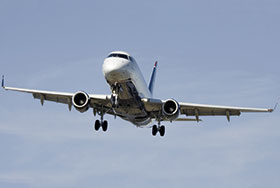

More people than ever before are using aviation to travel. In fact, there were over 78 million passengers at UK airports in the third quarter of 2015 alone, according to travel statistics from the Civil Aviation Authority. As such, it is increasingly important that aircraft are designed and built to provide a reliably safe journey. Graham Mackrell, managing director of precision gearing specialist, Harmonic Drive looks at how low temperature gears are key to ensuring safety in commercial aircraft.
More people than ever before are using aviation to travel. In fact, there were over 78 million passengers at UK airports in the third quarter of 2015 alone, according to travel statistics from the Civil Aviation Authority. As such, it is increasingly important that aircraft are designed and built to provide a reliably safe journey. Graham Mackrell, managing director of precision gearing specialist, Harmonic Drive looks at how low temperature gears are key to ensuring safety in commercial aircraft.
Whether it’s travelling to a business meeting or jetting off to enjoy a relaxing holiday, aviation is an important part of modern life. While the number of commercial flights in recent years has not matched the peak levels of 2007, which saw over two million aircraft journeys over the course of the year, it has certainly been rising in popularity since 2012.
Of course, safety concerns are inherent with any form of transport that involves travelling at 10 000 metres. With aviation rising in popularity, it is crucial that an aircraft is designed and built in a way that can ensure effective operation at high altitudes and under the extreme conditions that occur at those heights.
Fortunately, modern engineering means we are now able to provide the kind of reliability and repeatability that the industry demands. This is reflected in the accident rates for commercial air transport, which have been steadily declining since the 1950s. This decline in accidents can only continue with the use of durable components, especially gears for the leading-edge slats and flaps that can perform under extremely cold conditions.
Anybody who has been fortunate – or unlucky, depending on your perspective – to sit just behind the aircraft wings on a flight has likely seen flaps in action. These devices are mounted onto the trailing edge of the wing and aid manoeuvrability by lowering the minimum flight speed and increasing the angle of descent. On the other side of the wing are slats, which allow the aircraft to achieve slower speeds and take off in shorter distances.
Both of these are operated from the flight control system with a series of sensors, known as the position pick-off unit (PPU), which is located on the wings. The PPU monitors the position of the flaps and provides position feedback. However, in order to do this, it requires gearing that can provide zero backlash and also survive the conditions of the wing exterior.
Unsurprisingly, the wings of an aircraft can get extremely cold during flights. Aside from occasionally forming contrails and inspiring conspiracy theories about chemtrails, these temperatures can make it challenging for gears to function effectively due to the impact this has on gear lubricants.
As temperatures decrease, the viscosity of many gear oils increases and this subsequently results in higher levels of torque and increased stress on the gear itself. This stress negatively affects the performance of the gear in the short term and ultimately leads to breakages, with more frequent maintenance needed in the meantime.
With this in mind, it is important that manufacturers of systems designed to operate on aircraft wings choose their gears carefully. For example, Harmonic Drive’s HFUC-2A low temperature gear set not only delivers high positioning accuracy and zero backlash, it also comes with a specially formulated lubricant that allows it to operate at temperatures of -40°C.
This tolerance to low temperatures means that the lubricant does not become more viscous during use, reducing the need for maintenance. In fact, Harmonic Drive gears are designed so that they can last for the lifetime of the aircraft without the need for maintenance and without sacrificing performance.
It is feats of engineering like this that are making aviation safer. By thoroughly testing flight-critical components such as gears, to ensure they provide consistent performance across the lifespan of the aircraft itself, we will see aviation match, and even exceed, its safety record.
For more information contact Rhi Guthrie, Shrike Marine, +27 (0)21 447 6877, sales@shrikemarine.com, www.shrikemarine.com

© Technews Publishing (Pty) Ltd | All Rights Reserved